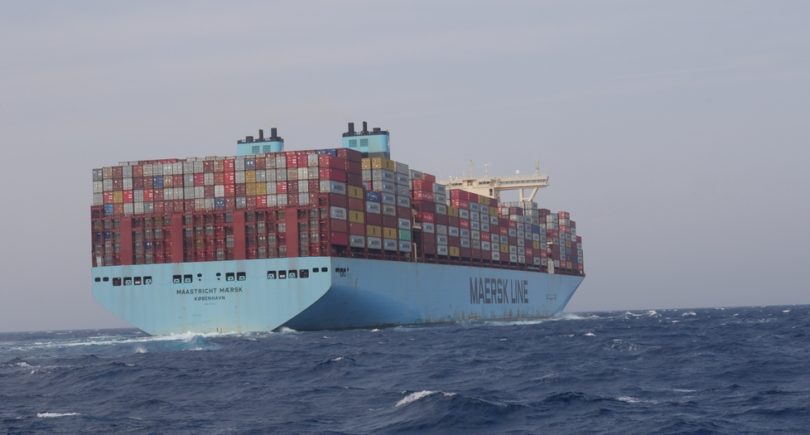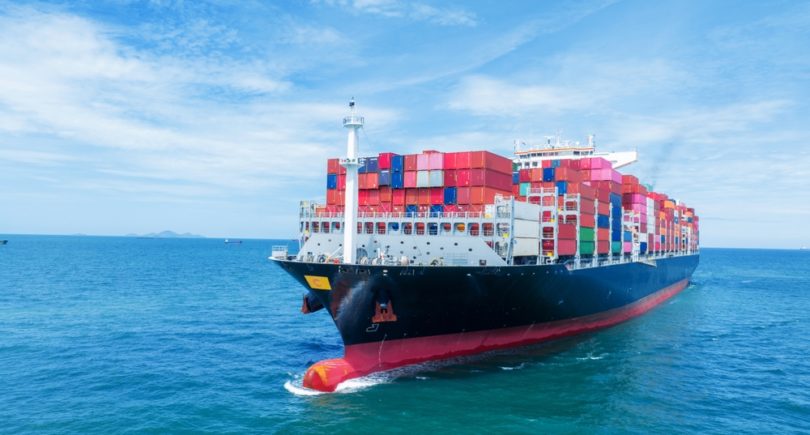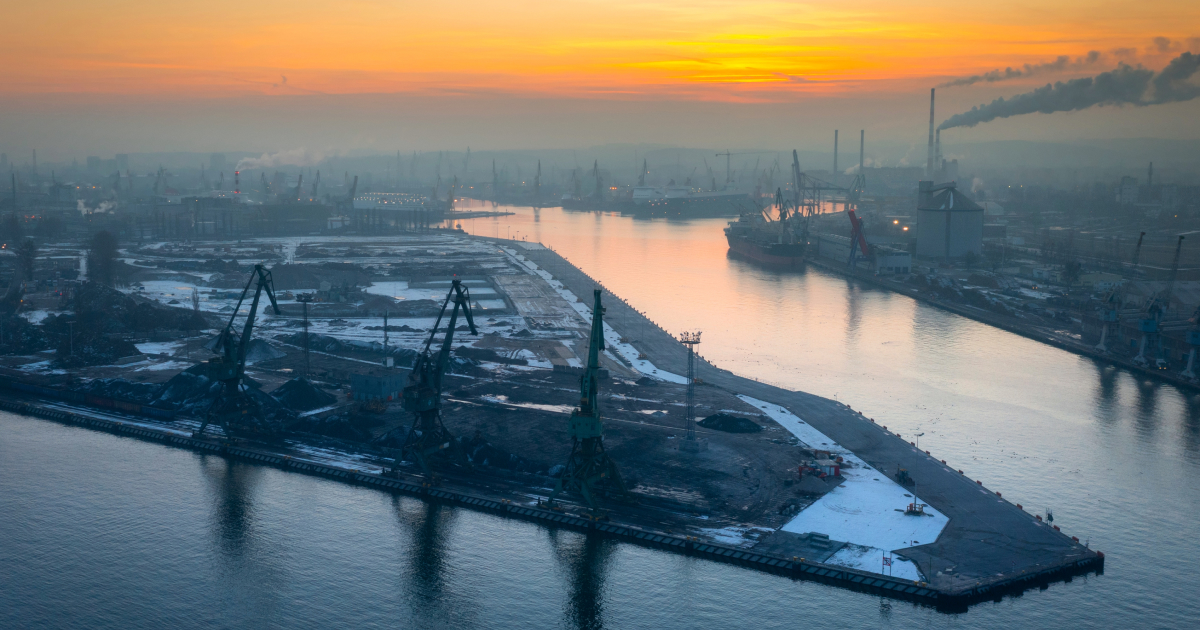
Posts Infrastructure Poland 3221 21 February 2024
Traditionally, growth due to transshipment of coal and liquid fuel. Ore and metals are not a priority for Polish ports
The seaports of Poland – Gdansk, Gdynia and Szczecin-Swinoujście – handled 145.72 million tons of cargo in 2023, up 9.8% compared to 2022 and 28.8% compared to 2021, which is a record high overall.
In general, the positive dynamics of cargo transshipment in the ports of Poland has been observed since 2021, in particular:
- 2019 – 108.3 million tons;
- 2020 – 103.84 million tons (-4.3% y/y);
- 2021 – 113.1 million tons (+8.9% y/y);
- 2022 – 132.7 million tons (+17.4% y/y);
- 2023 – 145.7 million tons (+9.8% y/y).
In 2020, the decline in cargo handling at Polish ports was caused by the effects of the COVID-19 pandemic, after reaching a record high in 2019. In 2021, the results of seaports recovered slightly, but in 2022 there was a sharp increase in transshipment, which is likely due to the beginning of the full-scale Russian invasion of Ukraine and changes in logistics flows.
The main sea artery of Poland is the port of Gdansk. In 2023, the company handled 81 million tons of cargo, which is almost twice as much as in 2019 (52.2 million tons). In 2022, the Port of Gdansk handled 68 million tons of cargo, and in 2021 – 53.2 million tons.
The sharp increase in cargo handling was driven by an increase in the transshipment of fuel cargo and coal. In 2023, the port of Gdansk handled 37.6 million tons (+47.3% y/y) of liquid fuel cargo and 13.4 million tons (+1.5% y/y) of coal. At the same time, in 2021, such cargo was handled at 18.9 million tons and 4.8 million tons, respectively. The increase in energy transshipment was caused by sanctions against the relevant products originating from the Russian Federation, which were introduced in 2022. Also in 2023, grains showed a sharp increase – by 63.2% y/y, to 3.1 million tons.
The second largest port complex in terms of transshipment is the Szczecin-Swinoujście port complex. In 2023, the company handled 35.32 million tons of cargo, which is 4% less than in 2022. At the same time, the figure increased by 6.4% compared to 2021, and by 13.3% compared to 2020.
Fuel cargo accounts for the bulk of transshipment at the port of Szczecin-Swinoujście, with 12.94 million tons (-10.4% y/y). The port also handled 2.63 million tons of grain (+59.5% y/y) and 1.13 million tons of ore (-46.1% y/y).
The Polish port of Gdynia handled another 29.4 million tons of cargo in 2023. The figure increased by 5.3% compared to 2022, by 10.1% to 2021, and by 19.2% – to 2020. The main cargo of the port is grain. Last year, the port handled 6.76 million tons of grain (+42.7% y/y), which is a record high. The port also handled 2.82 million tons of coal. This is down 17% y/y, but 2.2 times more by 2021.
The main reason for the sharp increase is the increase in the handling of fuel cargo, in particular gas and coal. This is due to the abandonment of Russian energy resources and the transition to alternative markets.
Iron and steel production
The handling of iron and steel products in Polish ports has been showing negative dynamics since 2021. In particular, iron ore transshipment in 2020 increased by 6.5% – to about 6.78 million tons, but has been gradually declining since 2021:
- 2021 – ≈6.7 million tons (-5.8% y/y);
- 2022 – ≈6.2 million tons (-2.8% y/y);
- 2023 – ≈4.9 million tons (-20.4% y/y).
In 2023, the port of Gdansk handled 3.8 million tons of bulk cargo, including iron ore, which is 7.3% less than in the previous year, Gdynia – 8 thousand tons of iron ore (+33.3% y/y), Szczecin-Swinoujście – 1.13 million tons of iron ore (-46.1% y/y). At the same time, the port of Gdynia has not handled iron ore cargo since 2017, which indicates that transshipment has resumed thanks to Ukrainian shippers who have lost access to domestic ports since the start of the full-scale war.
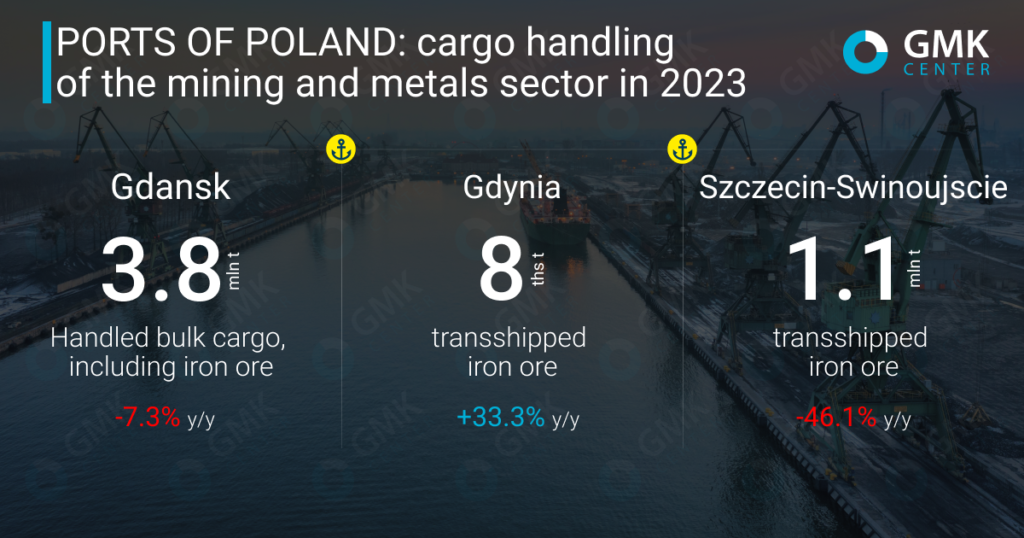
Polish port operators are reluctant to transship Ukrainian iron and steel products, although this area is important for Ukrainian shippers, as Ukrainian companies are trying to use all opportunities to export products to keep the economy running. However, shippers face the following problems when exporting through Polish ports:
- priority for own cargo;
- lack of port capacity for transshipment (loading/unloading) of Ukrainian exports;
- lack of warehouse space for the accumulation of shipping lots.
This route was used by ArcelorMittal Kryvyi Rih and Metinvest, among others, but these deliveries were test runs and have not yet proven effective.
Limited logistics capabilities for Ukrainian exporters, including Polish ones, negatively affect the iron and s steelector and the industry as a whole. In 2023, Ukraine exported 17.7 million tons of ore, down 26% from 2022 and 60% from 2021. Exports of pig iron amounted to 1.25 million tons (-5.8% y/y), semi-finished products – 1.2 million tons (-36.7% y/y), and rolled products – 1.78 million tons (-27.9% y/y). These figures cannot be restored to pre-war levels in the current situation, but exports may improve if loyalty to Ukrainian cargoes in EU ports increases.
In 2024, the volume of Ukrainian cargoes that will go through Polish ports is likely to decrease significantly, as some of them will be shipped by Ukrainian ports after the sea corridor starts operating in August 2023. Its operation is not yet completely safe, but as of February 2024, more than 22 million tons of cargo of various types were shipped through this route. In the future, the corridor’s capacity is likely to increase and dependence on Polish ports will decrease, although they will remain an important destination until the full de-blockade of domestic ports is complete.
Port investments
Polish ports are quite active in implementing investment projects to modernize infrastructure and expand their capacity, but they do so based on their existing cargo flows, with only a small amount of consideration for Ukrainian exports and imports.
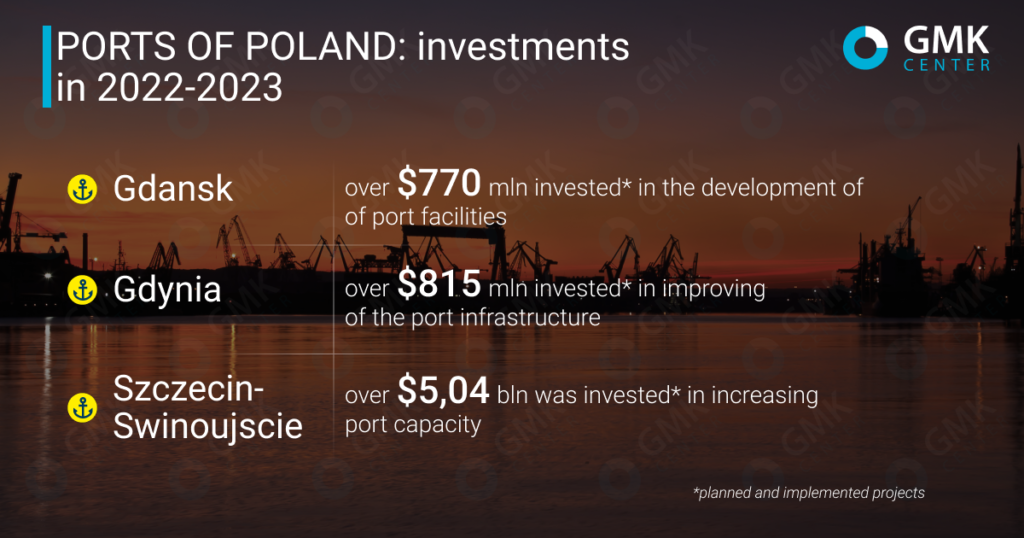
Gdansk
In 2022, the Port of Gdansk completed a $134 million project to modernize the fairway, expand berths, and improve navigation conditions in the inland port. The EU financed this project by 85% through the CEF. The port also received almost €100 million in CEF subsidies for the reconstruction of four berths with a total length of almost 2 km, along with underground and rail infrastructure. In addition, in 2022, an investment project to expand the railway infrastructure was completed at the deep-water container terminal DCT in the port of Gdansk.
The port operators plan to build a second deep-water berth for oil transshipment and a third deep-water container terminal. Investments in the second project will amount to about €470 million. At the first stage, the new terminal will increase throughput capacity by 1.7 million TEU to 4.5 million TEU per year.
In October 2023, a consortium of Morska Agencja Gdynia and Balta SA won a tender to lease almost 5 hectares of land in the Port of Gdansk. Within 3-4 years, a modern warehouse, storage areas and a railway line will be built on the leased area, mainly for bulk cargo.
The port is also planning to build a floating LNG terminal, which will meet more than 30% of the national gas demand. Its launch is scheduled for 2028. The project will be financed under the CEF program. The maximum amount of support will be €19.6 million. There are also plans to build two warehouse and shunting areas in the inland port with a total area of about 20 thousand meters, along with access roads, railroad connections, and the necessary infrastructure. The project is estimated at PLN 20 million (gross).
The last investment project launched in 2023 is the repair of the Inner Port’s industrial quay and replacement of its baffle. The investment is estimated at almost PLN 28 million. This will increase the technical depth of the berths to 10 meters, which will significantly improve the transshipment capabilities of the operators. The works are expected to be completed within two years.
Gdynia
In 2022, the port of Gdynia completed the construction of two concrete-coated warehouses with an area of almost 18 hectares. The first stage of the railway junction modernization was also completed with an investment of $206 million. 115 km of tracks and more than 350 turnouts will be modernized as part of the entire project, and access to the port will be electrified. 13 km of roads, a railroad bridge, and 2 railroad crossings will be restored. The investments are co-financed through the CEF and their total cost is approximately $370 million.
Gdynia is also planning to build an external deep-water port. Its expansion will almost double the port area for cargo transshipment and, accordingly, accommodate large container ships. These investments are estimated at around $370 million.
At the end of 2023, the port began a major reconstruction of the Helsinki embankment on a stretch of approximately 800 meters. The total cost of the works will be almost PLN 300 million (gross). The completion period is estimated at 26 months. The project will significantly improve the operational capabilities of this part of the port.
In January 2024, the Port of Gdynia began developing project documentation to improve road connections to the outer port. In particular, in 24 months it is planned to receive a project for the Red Road road connection, with the necessary reconstruction or construction of additional related infrastructure. Currently, the eastern terminals of the Port of Gdynia are connected to the national road network by only four streets.
Szczecin-Swinoujscie
In 2022, the Dembytskyi Canal was dredged to a depth of 12.5 meters. The port also invested $320 million in the reconstruction of railroad tracks. In addition, it was planned to build a new Norwegian pier and modernize the existing Czech and Slovak piers. These projects are co-financed by the EU. The total investment is about $84 million.
A deep-water container terminal is planned to be built in the outer port of Swinoujscie. The investment can be implemented in two stages, with the first stage handling 1 million TEUs per year. In total, the terminal will be able to handle up to 2 million TEUs per year. The new terminal is expected to start operating in early 2028. This investment is also associated with the expansion of infrastructure, including almost 100 km of railway network and the S3 expressway along the Polish border, which is scheduled to be completed by 2024.
The EU has also agreed on half (€4.3 billion) of the investment for the construction of a multimodal rail transshipment hub in Ostrow Grabowski in the port of Szczecin.
The implementation of these investment projects in Polish ports will expand the capacity of the port infrastructure, which will enable Ukraine to use Polish ports more actively for both imports and exports.
«The strengthening of mutually beneficial economic ties between Ukraine and Poland can be based primarily on the development of logistics infrastructure: road, rail, and port. Despite the operation of the temporary sea corridor, Polish logistics infrastructure remains key for Ukraine in its trade flows with the EU and the world,» comments Stanislav Zinchenko, CEO of GMK Center.


